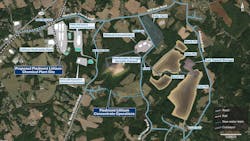Climate v. Environment: EVs Stoke Uncomfortable Debate
It’s difficult to open a news feed these days without hearing or reading about electric vehicles (EV). Even this column has devoted several pieces to the subject in recent years.
Undoubtedly, EV will eventually provide a significant part of the solution to reducing the greenhouse gas (GHG) emissions associated with transportation, the largest contributor in the U.S.
But ever since the introduction of hybrid vehicles, one of the major concerns with EV has continued to be batteries. Not only do they require large amounts of energy (which translates to carbon emissions) to produce and to dispose of, but they also rely on limited natural resources, the primary one being lithium.
Lithium battery production is dominated by China, with an estimated global market share of more than 50%. Korea and Japan account for another 36% combined. The market size of lithium battery manufacturing in the U.S., which was not that significant to begin with, has declined an average of 0.5% per year between 2017 and 2022. Of course, you have to have lithium to make lithium batteries and most of that – 51,000 tons – comes from Australia, Chile (16,000 tons), China (8,000 tons), and Argentina (6,200 tons). Chile, however, leads in the known lithium reserves, with 8 million tons.
For its part, the U.S. produces a negligible amount of lithium and has only an estimated 35,000 tons of reserves.
But that could change. Piedmont Lithium CEO Keith Phillips told Yahoo Finance Live in a recent interview: “Yes, we'll [eventually] have enough, but not by that time. There's going to be a real crunch to get the material. We don't have enough in the world to turn that much [lithium] production by 2035."
Not that his company isn’t trying to do its part. Piedmont Lithium has applied for state air quality and mining permits to build four open-pit mines, 500-ft deep, on farmland and woods, and to build a processing facility as part of the 1,500-acre project, a half-hour from Charlotte, NC (pictured above). Lithium deposits are found in what’s known as the Carolina Tin-Spodumene Belt (spodumene is a lithium aluminum silicate mineral). The TSB, as it’s known, is one of the world's most significant spodumene occurrences, and was significantly mined in the 1980s and 1990s, before cheaper sources were found in South America and Eurasia.
Today, however, neighbors – and many politicians – who otherwise favor EV and reducing greenhouse gas emissions – are, not surprisingly, adamantly opposed to the local mining. The question is how environmentally responsible can that type of operation be made? The community is not convinced (much of the opposition is, naturally, NIMBY). So it will be interesting to see the outcome of this round of climate vs. environment. Stay tuned.
A regular contributor to HPAC Engineering and a member of its editorial advisory board, the author is a principal at Sustainable Performance Solutions LLC, a south Florida-based engineering firm focusing on energy and sustainability. He can be reached at [email protected].
About the Author
Larry Clark
A member of HPAC Engineering’s Editorial Advisory Board, Lawrence (Larry) Clark, QCxP, GGP, LEED AP+, is principal of Sustainable Performance Solutions LLC, a South Florida-based engineering firm focused on energy and sustainability consulting. He has more than two dozen published articles on HVAC- and energy-related topics to his credit and frequently lectures on green-building best practices, central-energy-plant optimization, and demand-controlled ventilation.
